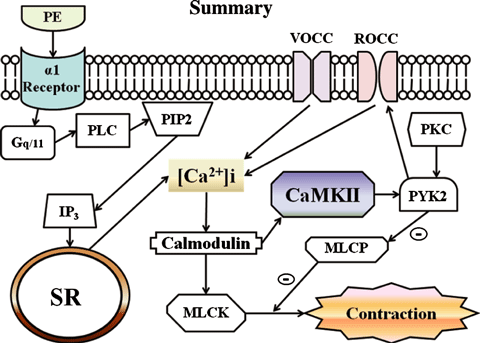 Min Tae Kim, Woo-Jae Park, Shin Kim, Ji Won Lee, Sang Yun Lee, Ju-Hong Jeon, Insuk So, Byung Joo Kim, Seon Jeong Kim
Min Tae Kim, Woo-Jae Park, Shin Kim, Ji Won Lee, Sang Yun Lee, Ju-Hong Jeon, Insuk So, Byung Joo Kim, Seon Jeong Kim
1 Department of Rehabilitation Medicine, Kwandong University of Medicine, Goyang, Korea.4 Division of Longevity and Biofunctional Medicine, Pusan National University, School of Korean Medicine, 5 Seon Jeong Kim, Center for Bio-Artificial Muscle and Department of Biomedical Engineering, Hanyang University.
*Corresponding author.E-mail: sjk@hanyang.ac.kr.
원문 링크 : http://onlinelibrary.wiley.com/doi/10.1111/j.1742-7843.2010.00623.x/full
Abstract
Sulphur mustard (SM) is an alkylating agent whose mechanism is not fully understood. To investigate the early action of SM, we examined the effect of SM on contraction of vascular smooth muscles. Phenylephrine (PE)-induced contraction was reduced by SM, but only marginally by 70 mM KCl-. Additional reduction was induced by nifedipine in SM-treated arteries. In the absence of extracellular Ca2+, contraction of arteries by PE was reduced, which was fully recovered by addition of 2 mM Ca2+. However, recovery was attenuated by pre-treatment with SM. The effect of SM on contraction by PE was not influenced by pre- and post-treatment with Phorbol 12, 13-dibutyrate. Calmodulin kinase II (CaMKII) was implicated as being responsible for the action of SM, because the contractile mechanisms of vascular smooth muscle via both Ca2+-calmodulin-myosin light chain kinase axis and protein kinase C-proline-rich tyrosine kinase axis were not related to the action of SM. Elevation of phosphorylated CaMKII level by Ionomycin or PE was attenuated by treatment of SM on western blot. CaMKII may be a candidate target molecule of SM in early stage contraction of vascular smooth muscle.